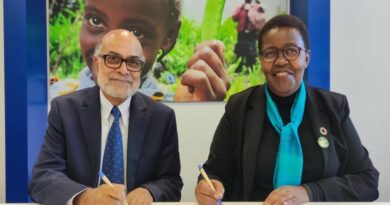Icrisat@50: Putting Icrisat’s Evolution In Perspective- A Three Article Series
22 February 2022, New Delhi: International Crops Research Institute for the Semi-Arid Tropics (ICRISAT) is celebrating its 50th year of establishment with the Prime Minister Narendra Modi launching the year-long celebrations on 5th February 2022 at ICRISAT’s headquarters in Hyderabad.
While ICRISAT takes immense pride in its contribution to improving livelihoods in Asia and Africa, the institute is mindful of the challenges ahead. Therefore, the year 2022, for ICRISAT, is not just a year of celebrations but it will also be a year to look back, look within and look forward.
The significance of ICRISAT’s beginning
Many scholars have noted that there is a clear-cut bias towards irrigated areas when it comes to public investment in agriculture and that the rainfed farmers are the most neglected, worldwide. Also, the paragraph at the head of this article, apart from reiterating the bias against dryland farming, also emphasizes some of the key areas to be addressed – more research and development, supporting policy and marketing.
The emergence of ICRISAT and its evolution over the years is in perfect alignment with these priorities. Although established in 1972, by a consortium formed by the Ford and Rockefeller Foundation with the support of the Indian Government, the thought process on setting up an exclusive institute for dryland crops had started much earlier, in 1966, just around the time Green Revolution got underway in India and many other developing countries in Asia. This implies that the development of dryland agriculture was indeed high on agenda for the international development agencies and the government of India.
While ICRISAT continues its world-class research in major dryland crops as also natural resource management in dryland ecosystems, the institute has broadened its engagement in the delivery of research outputs to the last mile through policy advocacy and by making earnest efforts of providing better access to markets for the farmers. Setting up of Genetic Resources Unit (Gene Bank) in 1979 meant that not only ICRISAT but also all other public as well as private research institutes could have access to the basic breeding material in 11 different dryland crops with a collection as large as 1,30,000 accessions. This, in a way, signifies the intent of founders of ICRISAT and the government of India, that dryland agriculture was indeed a priority, it was not really meant to be neglected. It is the quick and spectacular results of R & D in irrigated agriculture, especially among the ‘big 3’, rice, wheat, and maize, that took away major investments, possibly at the cost of dryland farming.
Now that there is a talk about ‘research fatigue’ in irrigated agriculture, excessive withdrawal of groundwater, increasing soil degradation and indiscriminate use of chemical inputs, dryland agriculture offers new opportunities for meeting the growing demand for food, nutrition, fodder and even fuel.
In this context let’s revisit the key features of dryland/ rainfed agriculture.
Interesting Facts on Rainfed Agriculture:
- India ranks first in rain-fed agriculture, both in area and value of produce.
- About 61 of India’s farmers rely on rain-fed agriculture and 55% of the gross cropped area is under rain-fed farming.
- Farmers in irrigated areas earn 60% of their income from agriculture. However, farmers in rainfed areas earn only 20-30% from farm-related activities.
- They account for 89% of millets production, 88% of pulses, 73% of cotton, 69% of oilseeds and 40% rice production in the country.
- Besides, rain-fed areas support 64% of cattle, 74 % of sheep and 78% of goat population in the country.
While the facts above are specific to India, the global situation is not much different. It is interesting to note what the Executive Heads of members of the Environment Management Group of the United Nations have to say (2011). They say the members are,
Conscious of the fact that drylands cover approximately 40% of the world’s land area, and support around two billion people, 90% of whom live in developing countries.
Mindful of the fact that unsustainable land and water use, and the impacts of climate change are driving the degradation of drylands to such an extent that approximately 6 million km2 (about 10%) is now degraded.
Deeply concerned that human well-being – in relation to health, food security, nutrition, material needs, social relations and security – is at risk from dryland degradation which costs developing countries an estimated 4–8% of their gross domestic product each year.
Convinced that the sustainable protection and enhancement of human well-being is a common denominator for the entire UN system, and that efforts to protect drylands significantly contribute to the safeguarding of human well-being by offering opportunities for local populations and providing regional and global benefits.
Aware that the potential local, regional, and global benefits that drylands may offer have not been fully utilized because of myths, market failures, a lack of public goods, weak incentives, high investment costs and gender inequalities.
Recognizing that many drylands in developing countries have become investment deserts, but that sustaining higher levels of investment can enhance productivity and increase incomes.
Further recognizing that the 10-year strategic plan of the United Nations Convention to Combat Desertification – which aims to forge a global partnership to reverse and prevent desertification and degradation to reduce poverty and support environmental sustainability – presents a major opportunity to address the underlying causes of land degradation.
Acknowledging that investments in drylands pay off if configured to the short- and long-term variability of these human-ecological systems, and that opportunities for investment in drylands exist for the public sector, the private large-scale commercial sector, the community sector, and the household or small-scale private sector.
In this backdrop ICRISAT, as global research for development (R4D) organization with its strong presence in Asia and Africa, recognizes that it has a lead role to play in improving lives and livelihoods dryland agriculture. In line with just about every concern of the UN, the ICRISAT’s holistic mission goals are,
- Overcoming poverty and hunger through stable and productive crops and systems,
- Reducing malnutrition by equipping smallholder farmers to grow more nutritious, resilient, and diverse foods,
- Preventing environmental degradation through sustainable natural resource management,
- Providing policy support to improve food availability and affordability.
The Gene Bank, the center of excellence in genomics and systems biology, Crop Breeding, seed systems, high throughput phenotyping facility, the center of excellence for climate change research in plant protection, starting the first agri-business incubator in India, the nutriplus knowledge programme, Digital Agriculture initiative, working with multiple partners through its outreach programme ICRISAT Development Center (IDC) etc., are but a few examples of ICRISAT’s broad and integrated approach to addressing both the challenges and the opportunities in dryland farming. More importantly, the seasoned scientists, the state-of-the-art research facilities and the experience accumulated over the past 5 decades are the precious resources available not merely for ICRISAT but every other stakeholder who is willing to work together towards a common cause.















